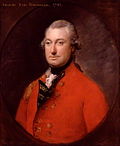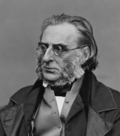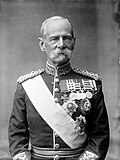| No. | Portrait | Commander-in-Chief | Took office | Left office | Time in office | Notes |
|---|
| 1 | | Craig, JamesGeneral
Sir James Craig
(1748–1812) | February 1801 | March 1801 | 1 month | Officiating. |
| 2 | | Lake, GeraldGeneral
Gerard Lake
(1744–1808) | March 1801 | July 1805 | 4 years, 4 months | Conducted a campaign with a string of victories that gave the British control of Northern India, Delhi and the Mughal emperor but failed to take Bhurtpore. Improved the Indian Army by making all arms, infantry, cavalry and artillery, more mobile and more manageable. |
| 3 | | Cornwallis, CharlesGeneral
The Earl Cornwallis
(1738–1805) | July 1805 | October 1805 | 3 months | Reappointment. With Sir Arthur Wellesley, he supervised the Second Anglo-Maratha War against the Sindhia and the Holkar. |
| (2) | | Lake, GeraldGeneral
The Lord Lake
(1744–1808) | October 1805 | 1806 | 0–1 years | Reappointment following the death of Cornwallis' successor John Graves Simcoe. Upon Cornwallis' death, Lake pursued the Holkar to the Punjab. The Holkar capitulated at Amritsar in December 1805. |
| 4 | | Simcoe, JohnGeneral
John Simcoe
(1752–1806) | 1806 | 26 October 1806 † | 0 years | Appointed to post in England in late 1805, but died before departing for India and replaced by Lake. |
| (2) | | Lake, GeraldGeneral
The Lord Lake
(1744–1808) | 1806 | October 1807 | 0–1 years | Reappointment following death of John Simcoe, who died after accepting the appointment in England. |
| 5 | | Hewett, GeorgeGeneral
Sir George Hewett
(1750–1840) | October 1807 | December 1807 | 2 months | Transformed Meerut into a British stronghold that became a launching point for future military campaigns into northern India. |
| 6 | | Champagné, ForbesLieutenant general
Forbes Champagné
(1754–1816) | December 1807 | January 1811 | 3 years, 1 month | Officiating. |
| 7 | | Nugent, GeorgeField Marshal
Sir George Nugent
(1757–1849) | January 1811 | October 1813 | 2 years, 9 months | – |
| 8 | | Hastings, FrancisGeneral
The Earl of Moira
(1754–1826) | October 1813 | January 1823 | 9 years, 3 months | 1st Marquess of Hastings from 1816; Oversaw British forces in the Gurkha War; conquered the Marathas; repaired the Mogul canals in Delhi; instituted educational reforms. |
| 9 | | Paget, EdwardGeneral
Sir Edward Paget
(1775–1849) | January 1823 | October 1825 | 2 years, 9 months | – |
| 10 | | Cotton, StapletonField Marshal
The Lord Combermere
(1773–1865) | October 1825 | January 1830 | 4 years, 3 months | 1st Viscount Combermere from 1827. Captured Bhurtpore (which Lake had failed to do) in 1824. |
| 11 | | Ramsay, GeorgeGeneral
The Earl of Dalhousie
(1770–1838) | January 1830 | January 1832 | 2 years | Began the British suppression of the Thuggee murder-cults. |
| 12 | | Barnes, EdwardLieutenant general
Sir Edward Barnes
(1776–1838) | January 1832 | October 1833 | 1 year, 9 months | Constructed the military road between Colombo and Kandy, made the first census of the population, and introduced coffee cultivation. |
| 13 | | Bentinck, WilliamGeneral
Lord William Bentinck
(1774–1839) | October 1833 | March 1835 | 1 year, 5 months | Suppressed the Hindu custom of sati . Reappointed in April 1834. |
| 14 | | Watson, JamesGeneral
Sir James Watson
(1772–1862) | March 1835 | September 1835 | 6 months | Established the famous police organisation known as the "Thuggee and Dacoity Department" within the Government of India. |
| 15 | | Fane, HenryGeneral
Sir Henry Fane
(1778–1840) | September 1835 | December 1839 | 4 years, 3 months | – |
| 16 | | Nicholls, JasperGeneral
Sir Jasper Nicolls
(1778–1849) | December 1839 | August 1843 | 3 years, 8 months | Officiating. |
| 17 | | Gough, HughField Marshal
Hugh Gough
(1779–1869) | August 1843 | May 1849 | 5 years, 9 months | 1st Baron Gough from 1846; Defeated the Mahrattas at Maharajpur. Conducted operations against the Sikhs and won the battles of Mudki, Ferozeshah and Sobraon. Soon after, the Sikhs surrendered at Lahore. |
| 18 | | Napier, CharlesGeneral
Sir Charles James Napier
(1782–1853) | May 1849 | December 1851 | 2 years, 7 months | Conquered Sindh and made it part of Bombay Presidency. |
| 19 | | Gomm, WilliamField Marshal
Sir William Gomm
(1784–1875) | December 1851 | January 1856 | 4 years, 1 month | – |
| 20 | | Anson, GeorgeMajor general
George Anson
(1797–1857) | January 1856 | 27 May 1857 † | 1 year, 4 months | Outbreak of the Indian Rebellion of 1857. Died of cholera during his march against the Indian Rebellion at Delhi. |
| 21 | | Grant, PatrickLieutenant general
Sir Patrick Grant
(1804–1895) | June 1857 | August 1857 | 2 months | Directed operations against the Indian Rebellion, sending forces under Havelock and Outram for the relief of Cawnpore and Lucknow, until the arrival of Sir Colin Campbell from England. |
| 22 | | Campbell, ColinGeneral
Sir Colin Campbell
(1792–1863) | August 1857 | 4 June 1861 | 3 years, 10 months | 1st Baron Clyde from 1858; Abandoned then recaptured Lucknow. Supervised military operations in Oudh until the Indian Rebellion had been subdued. |










































